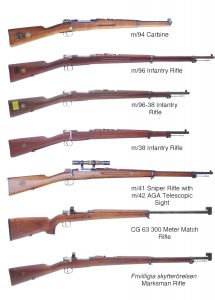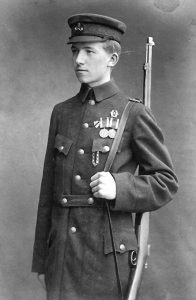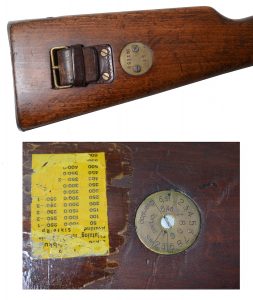 To learn more, visit www.northcapepubs.com or email [email protected].
To learn more, visit www.northcapepubs.com or email [email protected].
To purchase a Swedish Mauser on GunsAmerica.com, click this link: https://www.gunsamerica.com/Search.aspx?T=Swedish%20Mauser.
Editor’s Note: This piece was written by Joe Poyer, co-author of the book The Swedish Mauser Rifles, Revised, 3rd Edition. If you would like to explore the story of Sweden’s Mauser rifles in greater detail, you can obtain a copy of the book from North Cape Publications, Inc., PO Box 1027 Tustin, CA 92781. The price is $22.95 plus $5.75 postage.
Sweden, a Scandinavian country on the Baltic Sea with a 9.8-million population, is at about the same latitude as Canada. So, far away from the troubles of continental Europe, one would think that the Swedes would have little to fear, particularly as she fought her last war in 1810. But Sweden occupies a strategic position above continental Europe and has a border with Russia. Germany is only 100 miles away across the Baltic.
To maintain and ensure their neutrality, Sweden in the 19th and 20th centuries developed a well-trained military force based on conscription in which all young men would be trained, and subject to call-up in emergencies. It also developed some amazing military rifles. It paid off. All sides in both World Wars avoided antagonizing the Swedes.
The Swedish Mauser Rifle received its baptism of fire when Sweden sent some 77,000 m/96 rifles to Finland for use in the Winter War against Soviet Russia in 1939-1940.
The Swedish Carbine and Rifle
 In the mid-1890s, the Swedish government began to fear the developing rivalry between the great powers. It seemed only prudent to fortify her coasts and arm her army and navy with more modern weapons.
In the mid-1890s, the Swedish government began to fear the developing rivalry between the great powers. It seemed only prudent to fortify her coasts and arm her army and navy with more modern weapons.
Numerous military arms were tested to replace the army’s 1860s-era single-shot Remington Rolling Block rifles. They settled on a modification of the Mauser bolt-action rifle and carbine developed for Spain and Argentina. The German firm of Ludwig & Lowe manufactured 12,237 carbines and 40,000 rifles for the Swedes between 1894 and 1900. The Swedish government negotiated a license to build more at the Carl Gustafs Stad Faktori at Eskilstuna. An additional 115,000 carbines and 475,000 rifles were produced before production ceased in 1925.
During World War II, due to the expansion of her military forces, Husqvarna Vapenfabriks, AB built some 80,000 more infantry rifles, designated the m/38. The Husqvarna rifles were based on the shorter m/96-38, had beech wood stocks, and were marked with the name of the factory.
The Swedish Mauser carbine and rifles, Model of 1894 and 1896, are perhaps the most finely manufactured and finished military rifles ever made, in my personal opinion. Having examined hundreds in detail for our book, The Swedish Mauser Rifles, Revised, 3rd Edition, I can attest that every part is machined to strict tolerances and with very few, if any machine marks visible.
The 6.5x55mm Cartridge
 The flat-shooting 6.5x55mm cartridge was developed in Sweden and is renowned for its accuracy. The original cartridge used a 156-grain round nose bullet. In 1941, a new cartridge with a 139-grain spire-point bullet was adopted.
The flat-shooting 6.5x55mm cartridge was developed in Sweden and is renowned for its accuracy. The original cartridge used a 156-grain round nose bullet. In 1941, a new cartridge with a 139-grain spire-point bullet was adopted.
In a test performed a few years ago for the book, I shot five different Swedish Mauser rifles, three m/96 with 29.1-inch barrels and two m/96-38 with 23.1-inch barrels. Five shots were fired from each using the same bench rest setup on a windless and warm summer day at one hundred yards. All achieved groups between 0.92 and 1.20 inches, using surplus m/41 military ammunition. This is outstanding for a bolt action surplus military rifle! The 0.92 inch group was shot from one of the m/96-38 rifles with the shorter barrel.
Match Shooting in Sweden
In the 1920s, the Carl Gustafs Stad Faktori rebuilt some 500 m/96 rifles as the Fm/23 which had a heavier barrel and a sporter stock for issue to military officers for match shooting. This was the first attempt to turn the m/96 into a target rifle.
For many years, one of the most popular shooting competitions in Sweden was the 300-meter rifle match. Many rifles on the firing line were m/96 or m/96-38 surplus military models.
During World War II, the Frivilligia skytterörelsen, the Volunteer Shooting Society (now the Swedish Shooting Sports Federation), expanded beyond the supply of rifles. Again, Husqvarna manufactured some 20,000 m/38-96 rifles with 29.1-inch barrels which were sold to members at cost with the understanding that they would be sold back to the government at the same price if Sweden was drawn into the war.

The CG 63 was perhaps the finest shooting variation of the Swedish m/96 rifle. The rifle shown here is chambered in 6.5x55mm and shoots sub-minute of angle groups at 100 meters.
After World War II, the 300-meter matches grew in popularity. Once again, the factory stepped up and developed the CG 63 and CG 80, both heavy-barreled competition versions of the m/96 with sporter stocks which were for sale to all civilian shooters. Surplus m/96 receivers were used for these rifles and they were equipped with a variety of receiver-mounted sights by their owners. The CG 63 was chambered in 6.5x 55mm, 7.62×51 NATO and .22 rimfire calibers.

This young man is not a soldier but rather a member of the Frivilligia skytterörelsen shooting society.
The Details
The Swedish Mauser is a bolt-action rifle and feeds from an internal box magazine holding five 6.5x55mm cartridges. The rifle is full stocked and utilizes a 12.875-inch blade bayonet. The bayonet is unique in that the steel grip is hollow to slide over the cleaning rod secured in the forend.
The rifle is 49.5 inches long and weighs 9.2 lbs. empty. Cartridges are fed into the box magazine from a stripper clip through the open receiver with the bolt drawn back. The bolt handle on the m/96 is straight and protrudes to the right. The stock is European walnut with some replacement stocks made of beech.
Many m/96 rifles have a threaded muzzle. A false rumor spread almost as soon as the first shipping crate was opened that they were threaded for a silencer. Sorry to disappoint; they were threaded for a blank firing device that shredded the red wooden bullets loaded in the practice ammunition.

Two types of stock disks were used. The first type was marked with the regiment and rack number. The second type (below) was installed with the adoption of the m/41 239-grain, spire point bullet.
A brass disk was inset into the right side of the butt stock that originally listed regimental and rack numbers. When the m/41 cartridge was adopted, the brass disk markings were changed to show the amount of hold-over the shooter needed to apply with the new cartridge. Other information on the disk concerned the state of the bore. The disk was replaced on some imported rifles and carbines to include the importer’s name and information. A complete list of regiments and information for deciphering the later bore data is included in our book, The Swedish Mauser Rifles, Revised, 3rd Edition. Also, serial numbers by year and manufacturer are listed and the myriad of inspection and proof marks are illustrated and deciphered.
The Swedish Mauser Rifle and Carbine were first imported into the U.S., Canada and Germany in the mid-1950s. Swedish armories are long empty of the old rifles and carbines and virtually every variation has arrived in North America. There are fourteen different models with numerous variations—including three types of sniper rifles—to satisfy any collector. Ammunition is readily available and commercial cases are easy to reload (military ammunition was Berdan-primed, and not so easy).
 Editor’s Note: This piece was written by Joe Poyer, co-author of the book The Swedish Mauser Rifles, Revised, 3rd Edition. If you would like to explore the story of Sweden’s Mauser rifles in greater detail, you can obtain a copy of the book from North Cape Publications, Inc., PO Box 1027 Tustin, CA 92781. The price is $22.95 plus $5.75 postage.
Editor’s Note: This piece was written by Joe Poyer, co-author of the book The Swedish Mauser Rifles, Revised, 3rd Edition. If you would like to explore the story of Sweden’s Mauser rifles in greater detail, you can obtain a copy of the book from North Cape Publications, Inc., PO Box 1027 Tustin, CA 92781. The price is $22.95 plus $5.75 postage.
To learn more, visit www.northcapepubs.com or email [email protected].
To purchase a Swedish Mauser on GunsAmerica.com, click this link: https://www.gunsamerica.com/Search.aspx?T=Swedish%20Mauser.